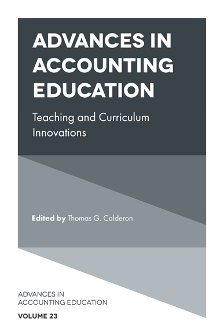Academic performance
, 48–49, 59–60
of accounting students
, 51–55
in higher education
, 50–51
Accounting
, 180–181
accreditation
, 70
policies to strengthen accounting graduates’ ethical skills
, 182–183
profession
, 69–70
research
, 4, 6
Accounting Advisory Board (AAB)
, 154
coordinate with faculty
, 157–158
courses for program
, 157
input impact on course topics and delivery
, 160
limitations
, 174
literature review
, 154–156
meeting with AAB
, 158
post-AAB meeting activities
, 158–159
process
, 156–157
research
, 174
results
, 159–161
selection
, 157
systems
, 164–167
traditional accounting
, 161–164
unstructured accounting
, 167–173
Accounting Advisory Councils
, 134–135, 147n1
background on advisory councils
, 136–138
demographics of survey participants’ departments
, 140
findings
, 139–145
gap between practice and academe
, 135–136
limitations
, 146–147
meeting characteristics
, 142
membership characteristics
, 142
membership engagement characteristics
, 144
organizational characteristics
, 141
research method
, 139
suggestions for future research
, 147
survey instrument
, 139, 149–151
value
, 145
Accounting Behavior and Organizations Section DC (ABO DC)
, 7
Accounting Case Search website
, 87
Accounting courses
, 49
academic performance in
, 48–49, 59
effect of gender differences
, 49–50
literature review
, 50
method
, 56–58
results
, 58–61
Accounting curricula
and data analytics
, 70–72
planning to have accounting data analytics course
, 72–73
data analytics in accounting curriculum
, 73–74
specific accounting data analytics course
, 73
Accounting department head
, 30
AACSB
, 30–31
compensation/salary conversion
, 41–42
demographics
, 34–36
difficulties and challenges
, 41
marketing department chairs
, 32–33
reasons for becoming department head
, 42–43
research
, 37–38
responsibilities
, 31
service
, 38–41
teaching
, 35, 37
training
, 35, 37
university accounting program leader
, 29–30
workload issues
, 35
Accounting Information Systems (AIS)
, 7, 155
Educators Conference
, 26–27
Accounting program
, 48
major challenges facing
, 41
stakeholders in
, 30
Accounting Standards Codification (ASC)
, 117
ASC 718 standard
, 84
ASC 805 standard
, 84
Accounting students
, 118
ethical skills
, 188–190
Accreditation Council for Business Schools and Programs (ACBSP)
, 39
Actual and perceived ethical foundations
, 187
Advanced Financial Reporting
, 170
Advisory councils
, 188–190
AMA-Sheth Foundation Doctoral Consortium
, 6
American Accounting Association (AAA)
, 4, 6, 84
allocation of doctoral consortia program time
, 8
consortia goals and objectives
, 7
consortia program focus
, 7–9
DC
, 5–9, 27
history
, 6–7
strategic vision project
, 27
American Institute of Certified Public Accountants (AICPA)
, 48, 84, 114, 134, 146, 179, 187–188
Code of Professional Conduct
, 189
Pre-Certification Core Competency Framework
, 86–87
American Marketing Association (AMA)
, 6
American Taxation Association (ATA)
, 6
Educators Conference
, 26–27
Analysis of covariance (ANCOVA)
, 49, 58
three-way mixed
, 57–58
Analytics
, 69 (see also Data analytics)
analytics-minded business graduates
, 68
Assessment
of effectiveness
, 89–91
tools
, 121
Association to Advance Collegiate Schools of Business (AACSB)
, 30, 34, 70, 134–135, 156, 181
accreditation
, 137, 139, 145–146
International Accounting Accreditation Standard A7
, 114, 118
Schools of Business
, 137
Standards for Accounting Accreditation
, 143
2013 AACSB Accreditation Standard A7
, 78–79
2018 AACSB Standard A5
, 78–79
Auditing section (AUD section)
, 7
Career management of doctoral consortia
, 19–22, 25–26
Career management sessions
, 8
Center for Advancing Accounting Research
, 27
Certified Public Accountants (CPAs)
, 30, 86, 178, 182, 184
accounting
, 180–181
accounting students’ ethical skills
, 188–190
advisory councils
, 188–190
business ethics
, 180–181
ethics education
, 181
policies to strengthen accounting graduates’ ethical skills
, 182–183
postgraduation ethics education
, 183–188
rules vs. principles distinction
, 179–180
State CPA Society Ethics CPE Offerings
, 185–186
Class exercise
, 84–86
assessment of effectiveness
, 89–91
implementation guidance
, 88
learning objectives
, 86–87
questions and solutions
, 94–98
“Closing the loop” process
, 154, 159
Code of Professional Conduct
, 184
College and University ethics education
, 181
“College without walls” concept
, 100
Committee of Sponsoring Organizations of Treadway Commission (COSO)
, 118
Conferences on Teaching and Learning (CTLA)
, 26
Continuing professional education (CPE)
, 179
ethics requirements
, 184, 187
Cooperative learning
, 100–101
Cybersecurity education
demand for cybersecurity professionals
, 117–118
related regulations
, 116–117
student feedback analysis
, 121–123
Data analytics
, 68
and accounting accreditation
, 70
accounting curricula
, 70
accounting education literature
, 68–69
and accounting profession
, 69–70
environment facing
, 69
fit in accounting curriculum
, 71–74
method
, 71
research questions
, 70–71
survey for accounting text/course
, 77
2018 AACSB Standard A5 vs. 2013 AACSB Accreditation Standard A7
, 78–79
Data/information security
, 117
Doctoral consortia (DC)
, 4
career management, networking, and integration
, 25–26
career management and networking
, 19–22
doctoral education
, 26
key characteristics of AAA DC
, 5
length of DC and mix of sessions
, 24–25
limitations and suggestions for future research
, 23–24
organizers and sponsors
, 4
overall survey responses
, 10
participants
, 9
questionnaire
, 9
recommendations
, 24–27
related literature
, 5–6
research
, 11–17, 25
survey and data
, 9–10
survey response rate and demographics
, 11
teaching
, 17–19
teaching initiatives
, 26–27
teaching sessions
, 25
Pathways Commission Report (PCR)
, 134, 146
Pathways integration approach
, 26
Performance-based metrics
, 30
Policies to strengthen accounting graduates’ ethical skills
, 182–183
Postgraduation ethics education
, 183–188
Pre-Certification Core Competency Framework
, 84
PricewaterhouseCoopers LLP (PwC)
, 69, 114
Professional
accountants
, 180
development skills
, 31
skepticism
, 164
skills
, 86
tax ethics standards
, 110n1
“Professional Code(s) of Conduct”
, 184
Professional Ethics course
, 164
Public Company Accounting Oversight Board (PCAOB)
, 163
Public Interest Section Doctoral Student and Early Scholar Consortium (PI)
, 6
